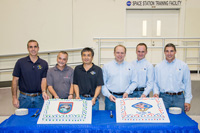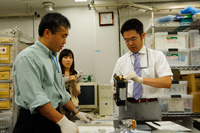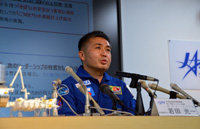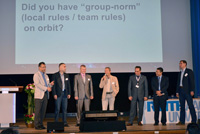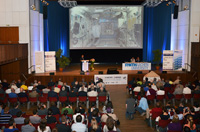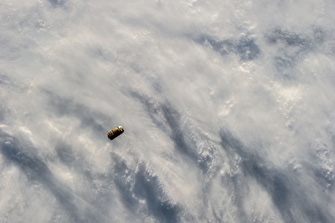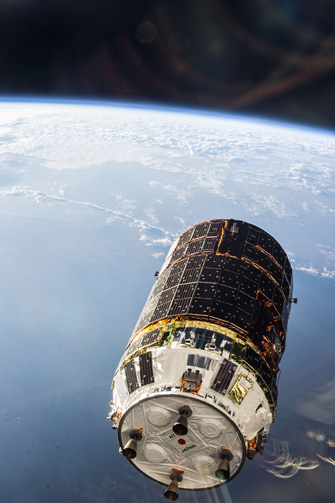Hello everyone. In July, I had the chance to return to Japan for the first time in a long while. Of course, working in Japan is really great fun and very rewarding. At the same time, when I come back to Japan, I wonder if the work we do and the accomplishments on the ISS (International Space Station) are being properly communicated to the Japanese people. As I am always saying, Japanese technological strength, the operational capabilities of Kibo and Kounotori and the quality of training for astronauts and controllers, etc. are very highly valued by the countries participating in the ISS. So every time doubts about the ISS's raison d'etre and investment in future manned space activities are raised in Japan, we always feel keenly that we are not fulfilling our responsibility to explain and we feel sorry about that.
There have been many accomplishments on the ISS but those that are comparatively well known are probably the discovery of X-ray novas with my beloved MAXI (Monitor of All-sky X-ray Image) and High Quality Protein Crystallization, etc. However, apart from these commonly known achievements, know-how about manned space development technology cultivated by the Kibo module, spacecraft and rocket technology such as HTV Kounotori and H-IIB and, further, the know-how and technology for operating these have been accumulated. Most importantly, the budgets for these are used within Japan and are creating employment as well as producing results in refining the latest technologies.
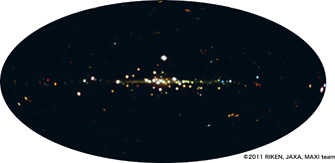
MAXI (Monitor of All-sky X-ray Image) is one of the devices that have made the greatest achievements on the ISS. In four years, it has discovered 12 X-ray novas and greatly contributes to global X-ray space observation. (Prior to MAXI, we only discovered 1 X-ray nova or so per year.)
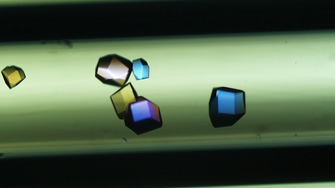
By making protein crystals in microgravity, it is possible to create high quality crystals and to analyse the crystalline structure in close detail. The development of new medicines or new catalysts, etc. is expected from this. It is also possible for many countries to participate in experiments as the price per sample is comparatively low. At the moment, Russia and Malaysia are participating in experiments but it would be good if more countries could participate in joint research in the future. (Photos supplied by: JAXA)
I don't think what I have been talking about so far will be particularly new information for people who are interested in space development and I imagine that there are many people who are raising doubts about the investment of 40 billion yen a year even though they acknowledge these accomplishments. (The yearly investment of 40 billion yen in the ISS is the equivalent of each person in Japan, including children, investing around 1 yen a day. I feel that I must work hard every day in order to respond to these expectations.)
To tell the truth, the greatest achievement of the ISS in my opinion is something that has not really come up in discussion up until now. I think this is a perfect opportunity for me to express my own personal thoughts on this.
The greatest achievement of the ISS in my opinion is its contribution to peace and safety in Japan.
Did you know that I used to be a fighter pilot in the Air Self-Defense Force? When I was working as a pilot, my goal was to be the strongest fighter pilot I could be. I worked hard every day based on the notion that if I was the strongest, there was no way I could lose and that if there were many pilots who had the ability to be unbeatable, no one would even think about attacking Japan!
After that, when I was working as a test pilot, I put all my energy into my work based on the notion that if we can provide pilots with efficient and easy-to-use equipment, the Self-Defense Force would become stronger and no one would even think about attacking Japan, with the motto, 'victory in the air comes from victory in technology'.
Furthermore, when I was working on coordination between Japan and the US at the Joint Staff Office, I believed that if I could maintain a good relationship with the US and create an environment in which we could work together when push came to shove, then other countries would acknowledge this and no one would even think about attacking Japan!
That's right. Until I became an astronaut, I put all my energy into how I could maintain the safety of my fellow citizens. Someone who thought all of the above feels every day that the greatest accomplishment of the ISS is its contribution to peace and safety in Japan. No, I believe that it has made an incredible accomplishment in peace not only in Japan but throughout Asia and the world!
To give an example, when I was a member of the Self-Defense Force, my impression of Russia was not particularly good. In the first place, not much good information about Russia filters into Japan and when I was a fighter pilot, I didn't need that kind of information... (National character and the opponent's strategy, etc. were important information but even if a pilot in the air knows that the people he is fighting against are good people, it only means that their job becomes more difficult.)
However, I was assigned to embark the ISS and I spent a lot of time in Russia and now I am really embarrassed about what I thought in the past. I believed that Japan was the most peaceful country in the world and I was very proud of that. So, even though there are many pro-Japanese people in Russia, when I found out that Japan was not like that, I felt fairly embarrassed about being a citizen sincerely aspiring to international peace.
When I saw the real Russia, I was able to see recognize the important of a partnership with Russia. And now, every day, I am putting all my energy into making Russian people understand the importance of a partnership with Japan.
In this way, both countries can create a good mutual relationship by working towards common goals while mutually recognizing each other's true strengths and as a result, can construct a peaceful relationship. The ISS is exactly that and the countries participating in the ISS are contributing to peace.
Incidentally, what do you think when you look at the current international situation surrounding Japan? There may be some of you who feel a little uneasy when you watch the news recently. However, through the activities on the ISS, Japan is greatly improving its safety and, if we can use the ISS wisely, I believe that it will be possible to further enhance these effects in the future.
As you all know, there is no way that Japan could ever initiate a war. In other words, unless another country attacks Japan, there will not be a war. And I believe that Japanese space development should be aiming to lead in the direction that makes sure that other countries are not tempted to attack Japan.
For example, if many different countries were able to conduct experiments on Japan's Kibo module, relationships of mutual trust would be furthered with those countries and it would be difficult for wars to start. And then, if these kinds of endeavours continued and the situation in which Japan leads Asian space development came to pass, countries would not run the risk of attacking Japan and being strongly criticized by many other countries.
This has all become a little complicated, so let me explain with a simple example.
In neighbourhood associations or school classes, if leaders who are intellectual and composed, who are considerate or who have knowledge of the martial arts and who do not in any way show off these abilities are leading everyone and, in addition, if the operation of the neighbourhood association or class is going well, that leader will be respected and if something happened to that leader, there would be a problem, wouldn't there? And it would be possible to avoid people taking a defiant attitude towards that leader and being strongly criticized by everyone.
If Japan is an indispensable presence for the people in the world like in the example above, Japan will be safe. And I think that Japan's space development will be one contribution to the people of the world.
I have ambitions for the 2015 mission. I hope to do experiments with many different countries using Kibo. And, if possible, I would like to conduct communications events, etc. with people from as many countries as possible during my stay on the ISS.
Some people may think, 'You're using our taxes so you should be working harder for Japan!' However, since I am getting the chance to work on the International Space Station, I want to work for many different countries. And I know that this will greatly contribute to the safety of Japan in the end. It is an important achievement upon which we cannot put a monetary value! This is the ISS's contribution to peace! I hope you understand what I mean.
